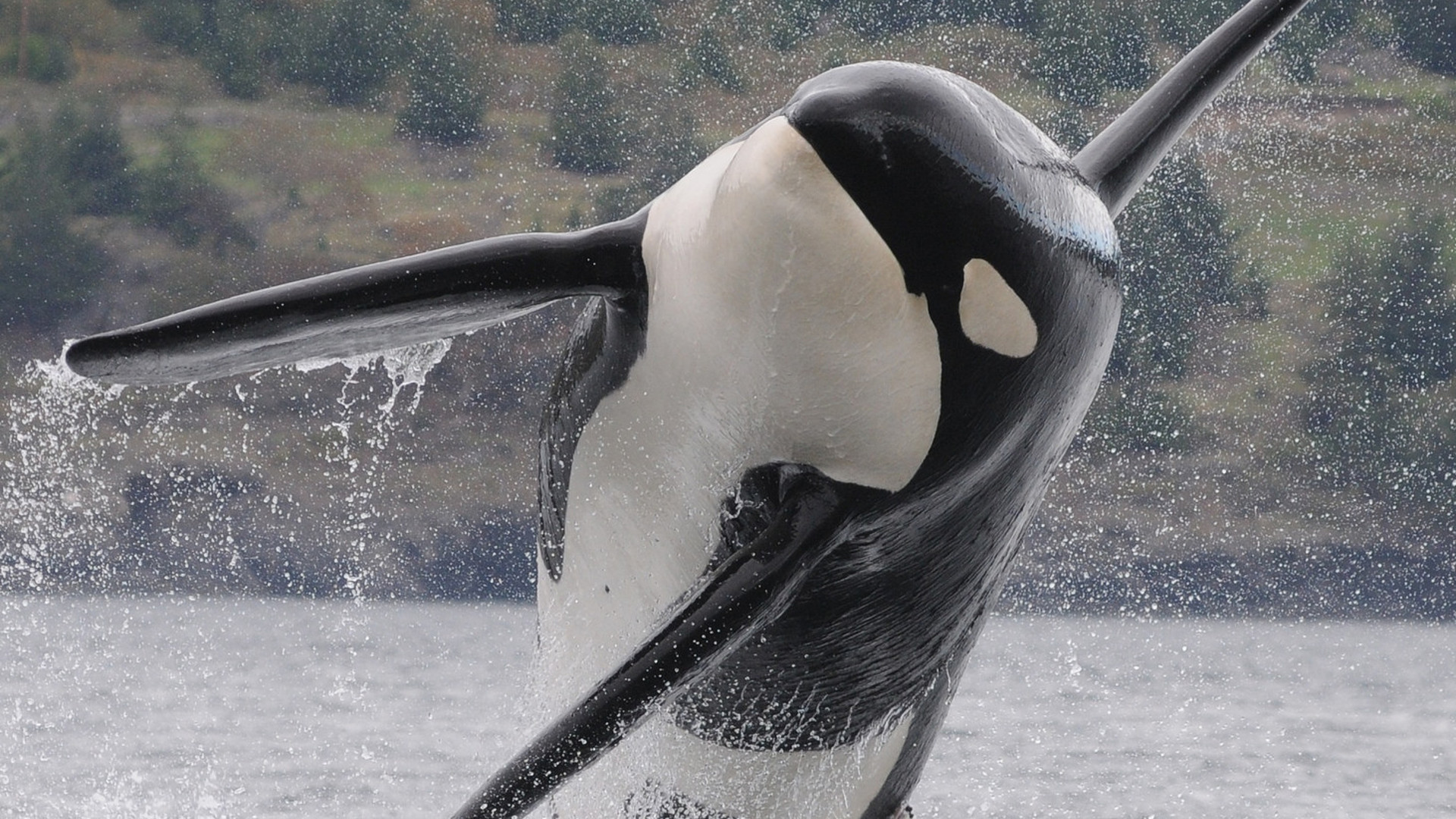The first time I saw wild killer whales, I was sitting on an upturned plastic bucket in a small Boston Whaler, cruising around the Salish Sea in the Pacific Northwest.
It was a cool, drizzly morning last October. At the wheel was cetacean expert Deborah Giles of the Center for Whale Research, located on Washington state’s San Juan Island. As we travelled along the island’s coasts, I could see the killer whales’ tall dorsal fins gracefully bobbing like black triangular sails, and slick flukes slipping beneath the calm waves. And of course I saw the whales’ faces, with their characteristic black-and-white grins and dark eyes, which curiously examined our boat.
In four hours Giles and I spotted 15 killer whales, ten of which belonged to an endangered population of about 80 whales in three pods known as the “Southern Residents” and five that belonged to a group of about 150 non-endangered “transients.” Southern Resident killer whales aren’t a separate subspecies but they are genetically and culturally distinct from other killer whale populations.
Most notably, they eat fish, while transients eat marine mammals like seals, walruses and other whales. In the past both populations were healthy, but in recent decades this food preference has led to the Southern Resident’s near-demise, with a more than 60 percent population drop since the late 1800s. In fact a recent report on the Southern Resident population has shown the killer whales’ birthrates have plunged, with 69 percent of pregnancies failing, most likely due to diminished populations of endangered Chinook salmon but also perhaps toxins in the few salmon that they manage to find and eat.
“There is little doubt that a limited supply of salmon is central to the problem,” said Samuel Wasser of the University of Washington, lead author of the study. “That said…its impacts are compounded by toxins stored in fat, bio-accumulated over the animals’ lifetimes. Food stress burns fat, releasing the toxins into circulation where they can do the most damage. Even here though, food stress is the trigger.”
Canada declared the Southern Residents endangered in 2001, and the United States followed suit in 2005, citing limited food supply, boat traffic and marine pollutants such as flame-retardants, pesticides and industrial solvents as major threats to the population. In his most recently published study, Wasser and his team of researchers at the University of Washington studied these factors and their health consequences for the Southern Residents between 2008 and 2014 by running endocrine tests on killer whale feces they found out on the Salish Sea. The team had unusual assistants help collect those samples: specially trained detection dogs that lay on the bow of research vessels and alert their human handlers of whales and whale feces, which the human handlers scoop up and bring into the ship.
When I visited San Juan Island, I met one of the detection dogs — an amiable black Labrador retriever named Tucker — and his handler, Elizabeth Seely of Conservation Canines at the Center for Conservation Biology at the University of Washington. Seely described the process of using to find a dog to find whale feces as “looking for a needle in a haystack but the haystack is constantly moving.” She said she watches Tucker and uses hand signals to instruct the boat’s driver, often Giles, to steer into the wind when Tucker begins acting excited — a sign he’s picked up a scent. Giles must watch Seely, the wind, the water and the whales in order to get close enough to scoop up the feces, but not close enough to startle the whale it came from.
Besides running fecal samples, the researchers counted, identified and assessed the nutritional status of whales visually. “Peanut head,” the name for the physical condition where a killer whale’s head becomes concave around the blowhole, is a sign of starvation, as is visibility of a whale’s ribcage, slanted eyes (indicative of a narrow face) and stunted growth. Use of drones has allowed scientists to easily detect some of these visible signs of starvation in whales from above.
According to experts, the reason for the starvation in the Southern Residents is most definitely a lack of salmon, which make up the largest and most nutritious part of their diet. Wasser and his fellow researchers found that levels of thyroid hormones were lowest in the Southern Resident whales following known drops in Chinook salmon from the Fraser River, while increases in salmon in the river were associated with increases in thyroid hormone levels.
In the past 10 years, salmon — particularly those spawning in the Columbia River — have decreased. While that’s certain, Wasser said what’s not well understood is why their numbers are dropping. Overfishing and habitat loss due to development could play a role in the fish’s demise. However, it appears more likely that the construction of hydroelectric dams on rivers where salmon spawn and migrate are to blame.
“Some say dams are key, including the Snake River dam, which impacts levels of early spring Chinook, some of the fattiest fish known and essential to replenish whales from the harsh winter and sustain them until the Fraser River Chinook run peaks in the summer,” said Wasser.
Giles takes a stronger personal stance when it comes to discussing the threats to survival the Southern Residents face. She said it’s clear that fishing restrictions and dam removal are necessary in order to replenish salmon and killer whale populations in the Pacific Northwest. But making her voice heard has been something she’s been criticized for doing as a scientist.
“I won’t stop telling the truth about what’s happening just because it’s politically ‘incorrect’ or unpopular,” said Giles. “We need to take action now or we’ll lose these genetically and culturally distinct whales forever.”
© 2017 Erica Cirino. All rights reserved.



Thanks for the awesome write-up, Erica. I’ve been working as a naturalist in the San Juan Islands for the past two summers and it’s been heartbreaking to see and learn about the decline of these whales. If you’re interested, I wrote about the Southern Resident Killer Whales from the perspective of a whale watch naturalist. Take a look! Thanks also for sharing this important information – we need to keep ourselves informed to make change.
https://www.lovesaltandsnow.com/journal/2017/7/5/do
What is the best way to take action to protect the resident pods? Who do we write and call about the dams and the pollution in the sound?